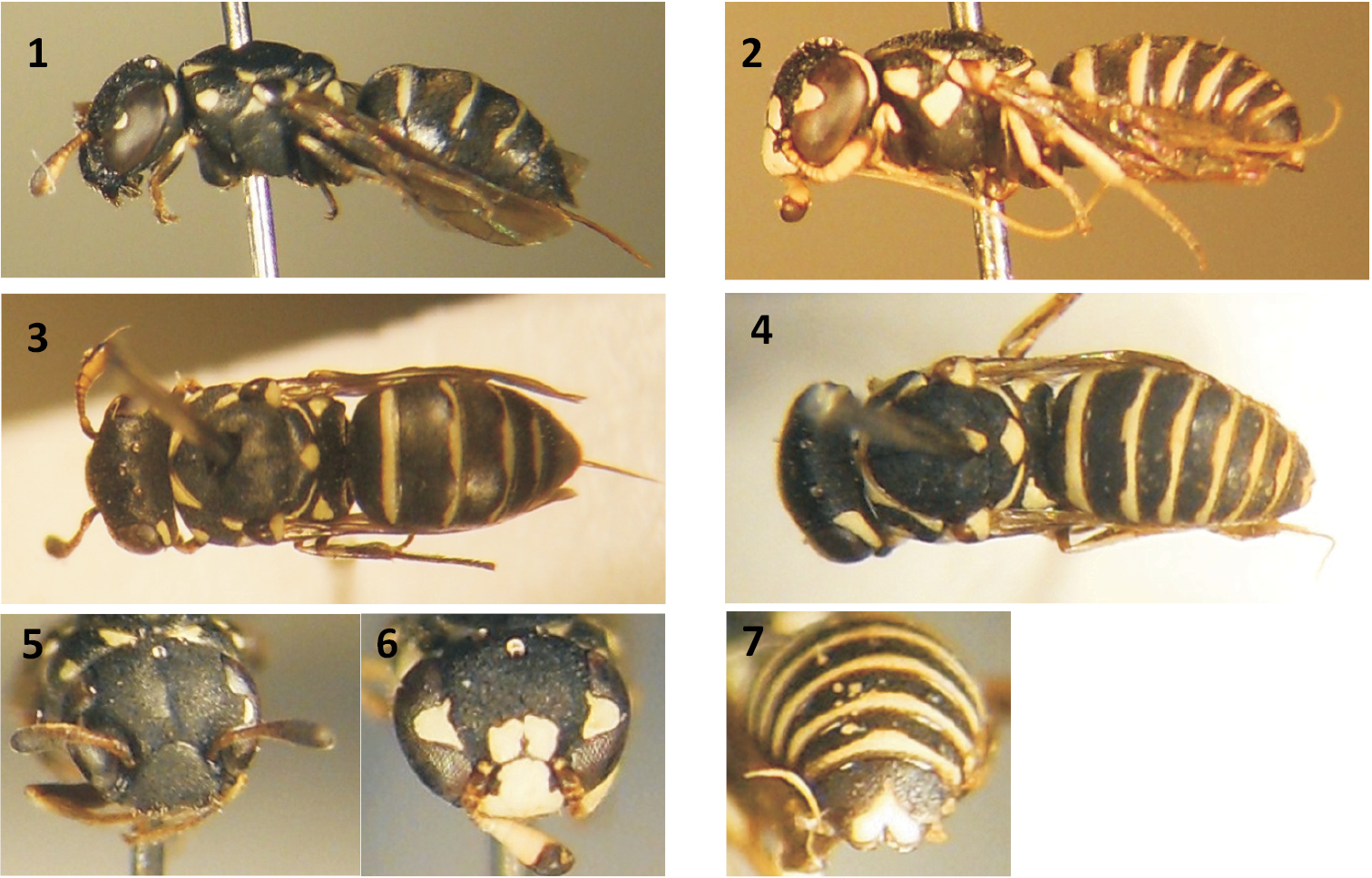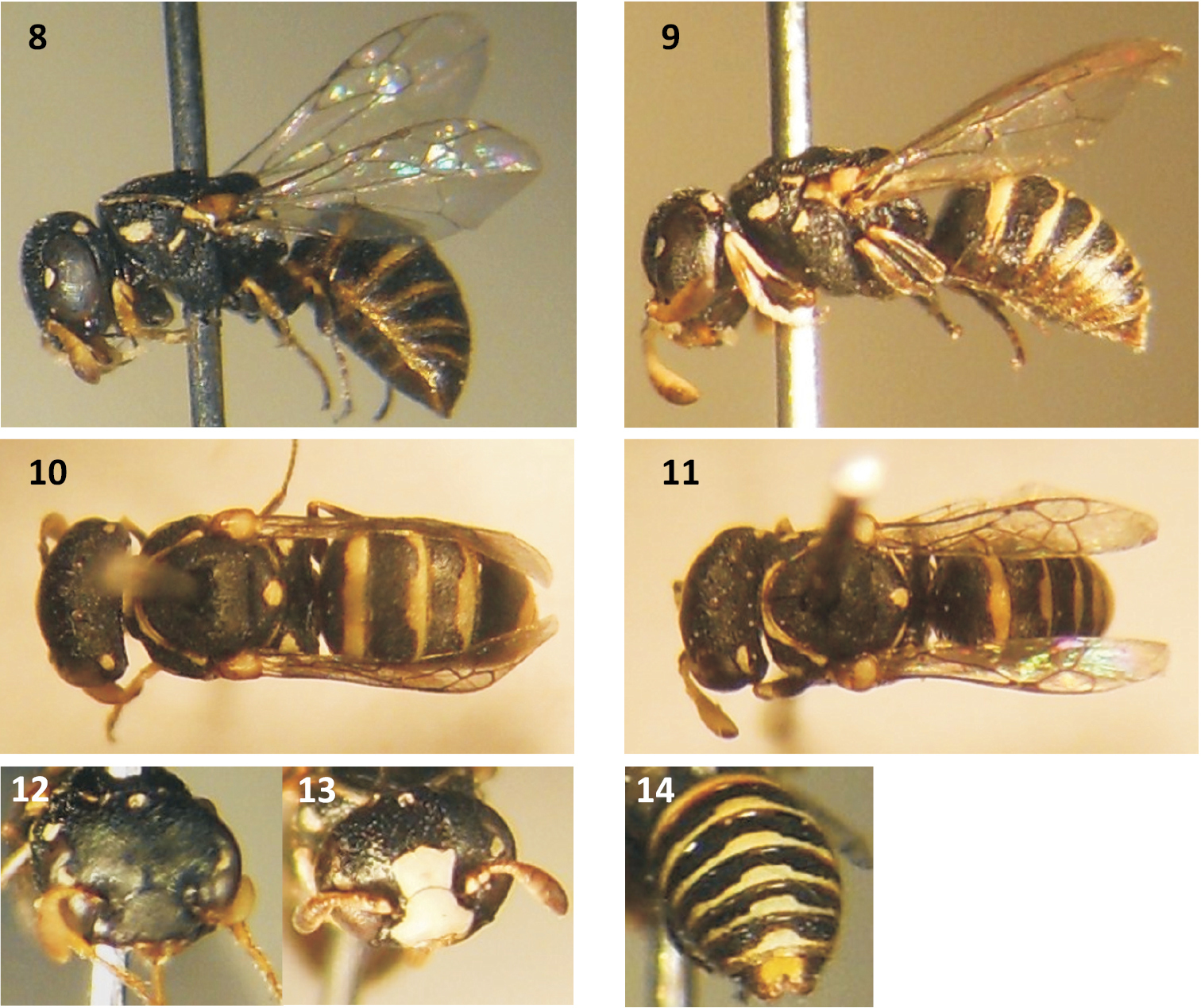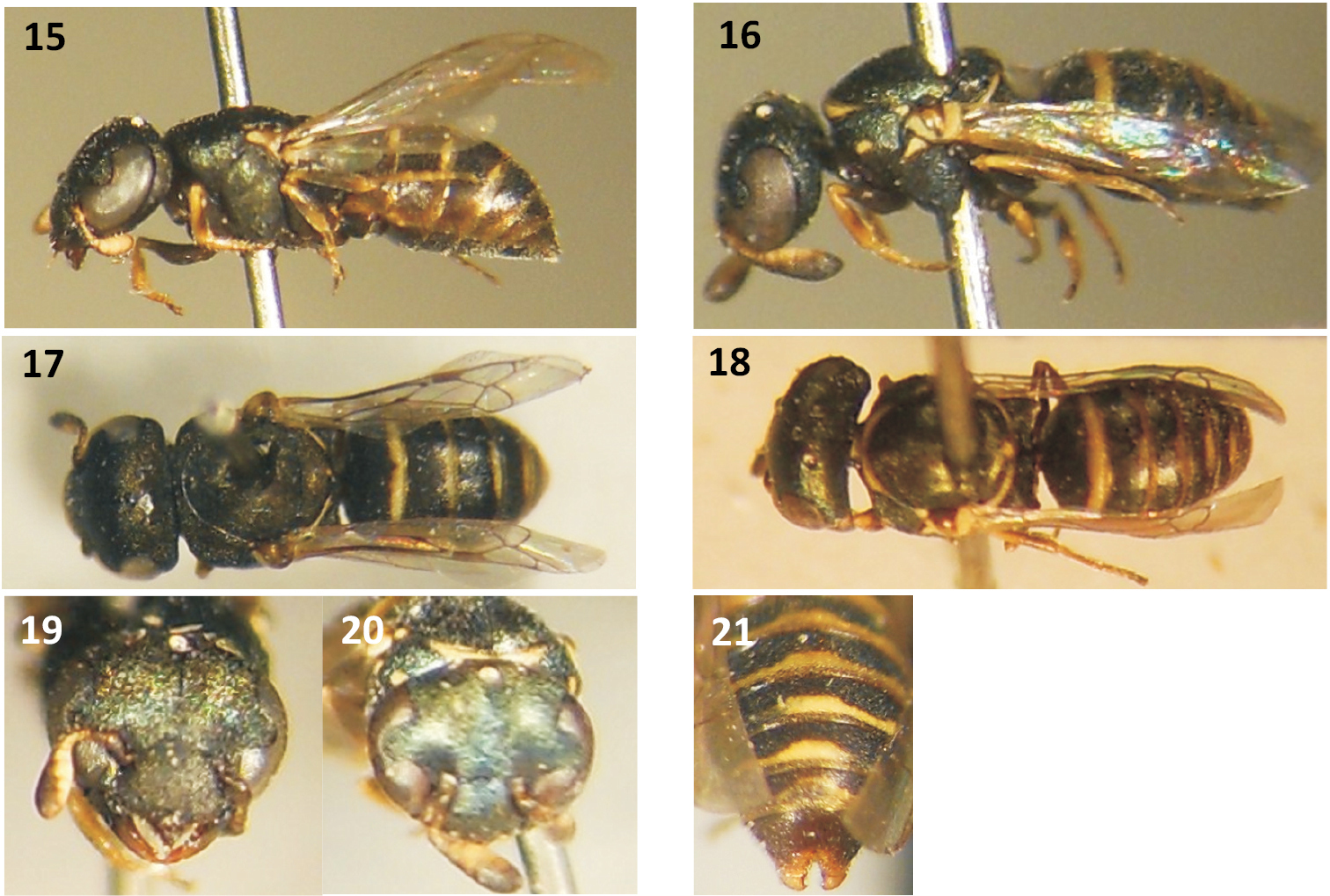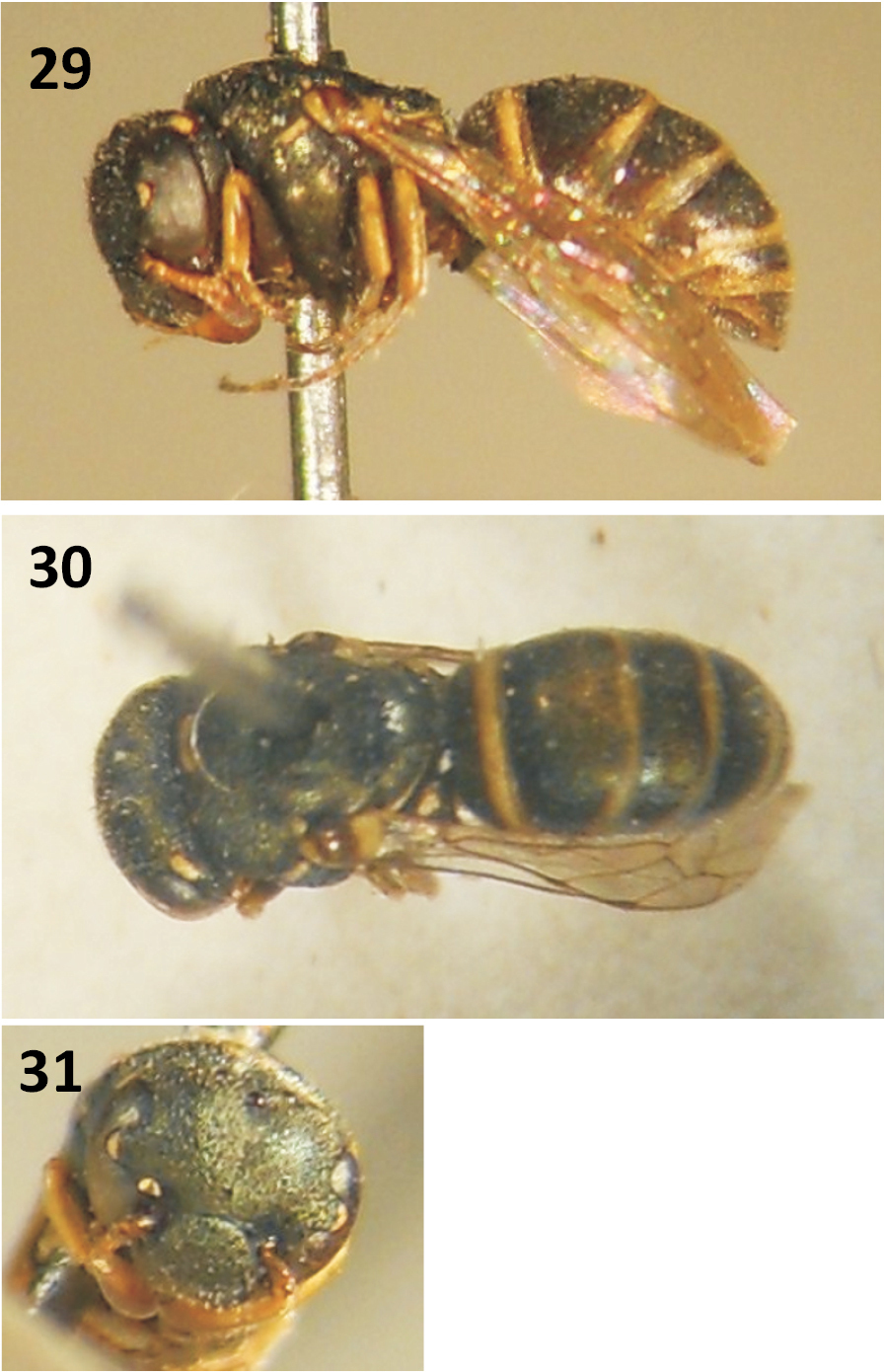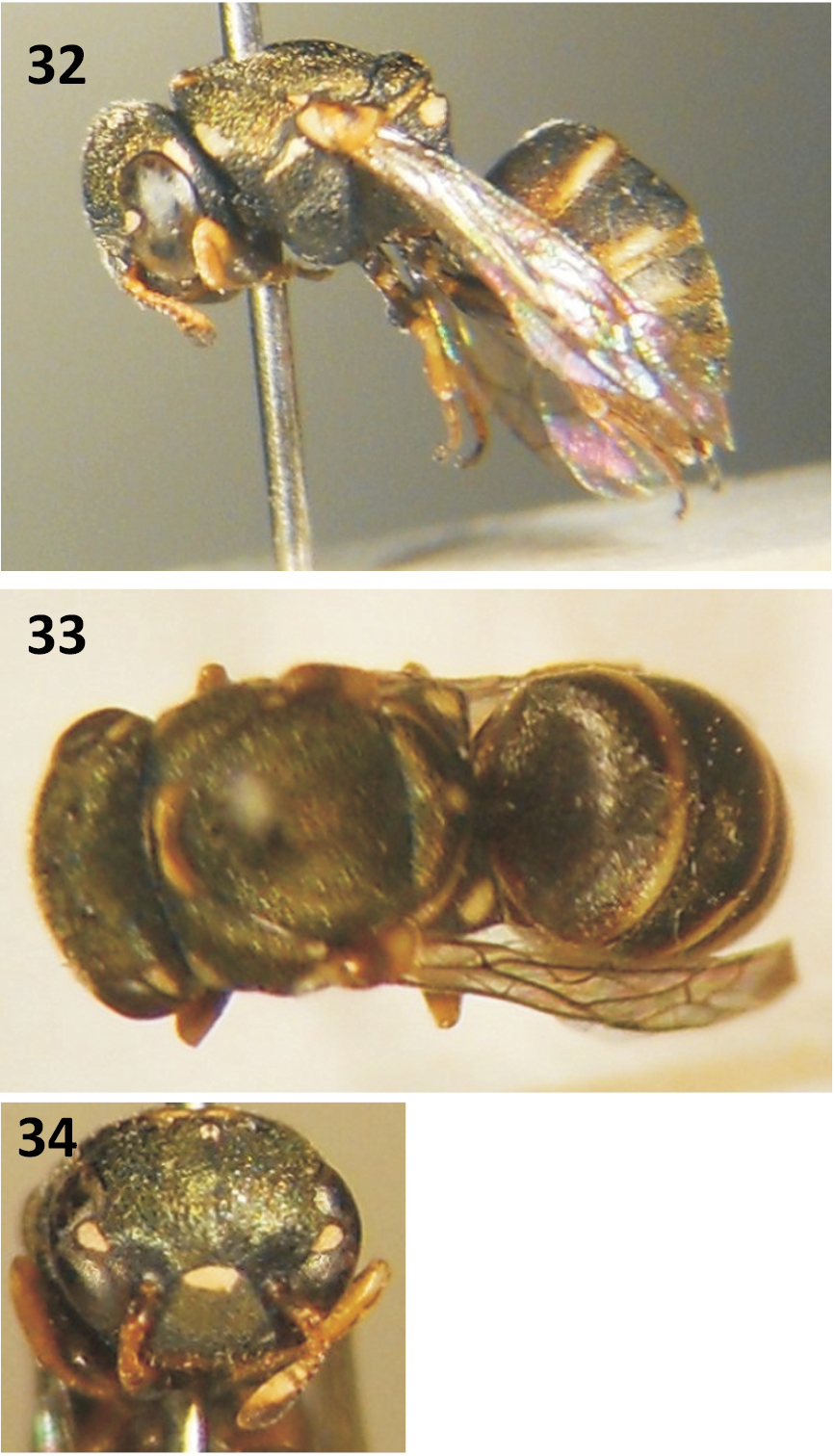






(C) 2011 Friedrich W. Gess. This is an open access article distributed under the terms of the Creative Commons Attribution License, which permits unrestricted use, distribution, and reproduction in any medium, provided the original author and source are credited.
For reference, use of the paginated PDF or printed version of this article is recommended.
In this publication, the fifth of a projected series revising the Afrotropicalspecies of the genus Quartinia Ed. André, 1884 (Hymenoptera: Vespidae: Masarinae), six species with incomplete venation are dealt with. Two new species are described, aenea from southern Namibia and aerosa from the Northern Cape of South Africa. These two species with greenish-metallic or broze-metallic head and mesosoma are compared with the known and similar looking helichrysi (Richards) and metallescens von Schulthess. Two further known species are dealt with, namely capensis Kohl and senecionis (Richards). Extensive collection data pertaining to most of the species contribute to the knowledge of their distribution and floral associations.
Southern Africa, taxonomy, floral associations
The background to the present state of knowledge of the taxonomy of the genus Quartinia Ed. André, 1884 has been fully stated in
Desirable as it might be to undertake a complete revision of the genus, this is at present not practicable. Rather than to get bogged down in a study which might never be completed and published, it is intended to publish a series of papers describing new species as well as reviewing some known species. It is envisioned that a new key to species will complete the series. To date Parts I, II and III have been published as
Quartinia species range in length from a little over 2 mm to 7 mm. In comparison with the great majority of species of other genera of Masarinae even the largest Quartinia are relatively small. In view of the considerable range in size shown by species of Quartinia and in order to express relative size, categories based on length have been established for species of the genus. These are minute (1.5–2.5 mm); small (2.5–3.5 mm); medium (3.5–4.5mm); large (4.5–5.5 mm); very large (5.5–6.5 mm) and gigantic (6.5–7.5 mm).
The present paper deals only with species with incomplete venation (2m-cu present but attenuate and interrupted). In the past these species would have been placed in Quartinioides
Acronyms for institutions in which material is housed are: AMG = Albany Museum, Grahamstown, South Africa; BMNH = Natural History Museum, London, England.
Taxonomy A. Species with black head and mesosomahttp://species-id.net/wiki/Quartinia_capensis
Figs 1–7Small to medium sized (2.9–3.8 mm). Fore wing with Cu1a and 2m-cu present but attenuate, much thinner than other veins, and with 2m-cu interrupted before reaching M. Tegula white anteriorly and posteriorly; posterior inner corner inwardly produced. Black with white markings. Tibiae of female black except basally, those of male white. Male with labrum, clypeus, pair of large spots ventrally on frons, ocular sinus, streak on temple, underside of flagellomeres (except last flagellomere of club) white; clypeus falling steeply to anterior margin, with a marked median carina on anterior half.
Female (previously adequately described) (Figs 1, 3, 5).
Male (previously adequately described) (Figs 2, 4, 6, 7).
Quartinia capensis 1 ♀, lateral view (× 13) 2 ♂, lateral view (× 15) 3 ♀, dorsal view (× 13) 4 ♂, dorsal view (× 15) 5 ♀, head, front view (× 16) 6 ♂, head, front view (× 20) 7 ♂, tergum VII, dorsal view (× 22).
SOUTH AFRICA: EASTERN CAPE: Skoenmakerskop (34.04S, 25.35E) [near Port Elizabeth], 8.xi.2006 (F. W. and S. K. Gess), 4 ♀♀ (visiting white flowers of Sphalmanthus plenifolius (N. E. Br.) L. Bol., Aizoaceae: Mesembryanthema); same locality, 24.xi.2008 (F. W. and S. K. Gess), 1 ♀ (visiting white flowers of Sphalmanthus plenifolius) [AMG].WESTERN CAPE: Fransmanspunt (34.18S, 21.57E) [near Mossel Bay], 22.i.2002 (F. W. and S. K. Gess), 4 ♀♀, 5 ♂♂ (2 ♀♀, 5 ♂♂ visiting violet flowers of Limonium scabrum (Thunb.) Kuntze, Plumbaginaceae); 2 ♀♀ visiting pink flowers of “Drosanthemum” sp., Aizoaceae: Mesembryanthema) [AMG].
Aizoaceae: Mesembryanthema (“Drosanthemum”, Sphalmanthus); Plumbaginaceae (Limonium).
Unknown.
http://species-id.net/wiki/Quartinia_senecionis
Figs 8–14Small (2.5–3.0 mm). Fore wing with Cu1a and 2m-cu present but attenuate, much thinner than other veins, and with 2m-cu interrupted before reaching M. Tegula largely white, with a small brown area antero-medially; posterior inner corner absolutely rounded. Black with yellowish-white markings; mid and hind tibiae and tarsi mostly brown; frons and mesoscutum not appreciably shiny. Male with labrum, clypeus, large trapezoidal mark on frons, bottom of ocular sinus and spot on temple yellowish-white.
Female (previously adequately described)(Figs 8, 10, 12).
Male (previously adequately described) (Figs 9, 11, 13, 14).
Quartinia senecionis 8 ♀, lateral view (× 20) 9 ♂, lateral view (× 22) 10 ♀, dorsal view (× 19) 11 ♂, dorsal view (× 19) 12 ♀, head, front view (× 22) 13 ♂, head, front view (× 23) 14 ♂, tergum VII, dorsal view (× 26).
NAMIBIA: E[ast] of Gamsberg Pass (23.19S, 16.31E), 12.iii.1999 (F. W. and S. K. Gess), 3 ♀♀, 1 ♂ (visiting yellow flowers of Pentzia incana (Thunb.) Kuntze, Asteraceae). LESOTHO (formerly Basutoland]: Mamathes [29.07S, 27.49E], 12.xii.1954 (C. Jacot Guillarmod), 6 ♀♀, 1 ♂ paratypes (on flowers of Felicia muricata (Thunb.) Nees, Asteraceae) [as Aster muricatus]. SOUTH AFRICA: FREE STATE (formerly Orange Free State): Chard, near Ficksburg (28.56S, 27.45E), 6–8. xii.2008 (F. W. and S. K .Gess), 16 ♀♀, 2 ♂♂ (visiting flowers, disc yellow, rays mauve, of Felicia muricata); Thaba Nchu [29.13S, 26.51E] , 1.xii.1952 (C. Jacot Guillarmod), 9 ♀♀, 1 ♂ paratypes (on Senecio laevigatus Thunb.); S of Ladybrand (29.14S 27.23 E), 9.xii.2008 (F.W. and S. K. Gess), 32 ♀♀, 2 ♂♂ (visiting flowers of Felicia muricata); N of Wepener (29.27S, 27.13E), 9.xii.2008 (F. W. and S. K. Gess), 1 ♂ (visiting flowers of Felicia muricata); 8 km NE Smithfield (30.09S, 26.36E), 3.xii.2008 (F. W. and S. K. Gess), 1 ♀ (visiting flowers of Felicia muricata); 1 km NE Smithfield (30.11S, 26.33E), 3.xii.2008 (F. W. and S. K. Gess), 5 ♀♀, 1 ♂ (visiting yellow flowers of Pentzia incana).EASTERN CAPE: Near Aliwal North (30.44S, 26.47E), 11.xii.2008 (F. W. and S. K. Gess), 1 ♀, 3 ♂♂ (visiting flowers of Felicia muricata) – [all AMG].
SOUTH AFRICA: FREE STATE: Thaba Nchu [29.13S, 26.51E] (on flowers of Senecio laevigatus Thunberg). LESOTHO (formerly Basutoland): Mamathes [29.07S, 27.49E] (on flowers of Felicia muricata [as Aster muricatus]; Tebetebeng Mill [circa 29.11S 27.57E(on flowers of Gazania sp.).
In Namibia the species if known only from E of the Gamsberg Pass in the Highland Savanna of
The apparent disjunct distribution, possibly no more than a consequence of a geographical hiatus of collecting, finds a striking parallel in the distribution of Jugurtia confusa Richards (see
Asteraceae (Felicia, Gazania, Pentzia and Senecio).
Unknown.
urn:lsid:zoobank.org:act:45124B59-75AE-45BE-9E16-81908C6FFC73
http://species-id.net/wiki/Quartinia_aenea
Figs 15–21♀, NAMIBIA: 10 km west of Aus (26.39S, 16.09E), 7.ix.2002 (F. W. and S. K. Gess) (visiting yellow fls of Leysera gnaphalodes (L.) L., Asteraceae) [AMG].
NAMIBIA: c 15 km W Aus on road to Lüderitz[bucht] (26.37S, 16.06E), 21.ix.2003, 1 ♂ (visiting yellow fls, Asteraceae); NW Aus, drainage channel (26.37S, 16.12E), 17.ix.2005, 1 ♀ (visiting yellow flsLeysera [tenella DC.], Asteraceae); 10 km west of Aus (26.39S, 16.09E), 7.ix.2002, 39 ♀♀, 1 ♂ (visiting yellow fls of Leysera gnaphalodes (L.) L., Asteraceae); Klein-Aus Vista (26.39S 16.12 E), 8.ix.2002, 4 ♀♀ (visiting small yellow daisy [Dimorphotheca polyptera DC.], Asteraceae); SW Klein-Aus Vista (26.44S, 16.10E), 24.ix.2003, 1 ♀ (visiting yellow fls of Leysera, Asteraceae) – (all F. W. and S. K. Gess) [all AMG].
Small (2.7–3.2 mm). Fore wing with Cu1a and 2m-cu present but attenuate, much thinner than other veins, and with 2m-cu interrupted before reaching M. Head and mesosoma greenish-metallic. Tegula with posterior inner corner inwardly produced and angular, in dorsal view not attaining level of suture between mesoscutum and scutellum. Both sexes with head and dorsum of propodeum lacking white markings.
Female (Figs 15, 17, 19): Head and mesosoma dark metallic green with, depending on the angle of illumination, reddish-bronze lustre; gaster black. The following are whitish-yellow: underside of antenna; in a few specimens narrow transverse band, medially interrupted, on anterior margin of pronotum and in all specimens minute spot on postero-dorsal angle of same; tegula anteriorly and posteriorly; a minute to small spot postero-medially on scutellum; scutellar lamella laterally; posterior bands not reaching sides on terga I – IV (that on tergum I widest, those of terga II – IV anteriorly produced medially and laterally). Light ferruginous are: apex of femur of all legs, most of tibia of fore and middle legs, base and apex of hind leg, fore tarsomeres (in part). Darker ferruginous are: mandible distally; upper side of antenna; median band on hind tibia; tarsomeres (in part). Wings very lightly browned, slightly iridescent; veins brown.
Length 3.04–3.2 mm (average of 3: 3.13 mm); length of fore wing 2.1 mm; hamuli 4.
Head in front view 1.24 × as wide as long; microreticulate (shagreened); moderately shiny; with punctures barely discernable. POL: OOL = 1: 0.77. Clypeus 1.6 × as wide as long (to bottom of emargination); dorsal margin exceeding by about diameter of antennal socket level of an imaginary line joining top of antennal sockets; distal margin widely and shallowly emarginate, narrowly laminate.
Mesosoma microreticulate (shagreened) like head; moderately shiny; with punctures slightly more obvious than on head.
Gaster finely microreticulate, very indistinctly punctured, moderately shiny.
Male (Figs 16, 18, 20, 21): Coloration and markings as in female, with in addition the following whitish-yellow markings: short band on anterior margin of pronotum; small spot on humeral angle and streak at top of mesopleuron (both in one specimen only); short transverse bands on terga V and VI. Apex of tergum VII and parameres ferruginous. Surface sculpture and puncturation as in female.
Length 2.7 mm; length of fore wing 1.8 mm.
Head 1.28 × as wide as long; POL: OOL = 1: 0.82.
Tergum VII with a deep V-shaped slit; lateral lobes smoothly rounded apically. Sterna atuberculate.
Quartinia aenea 15 ♀, lateral view (× 16) 16 ♂, lateral view (× 21) 17 ♀, dorsal view (× 16) 18 ♂, dorsal view (× 16) 19 ♀, head, front view (× 22) 20 ♂, head, front view (× 23) 21 ♂, tergum VII, dorsal view (× 24).
The name aenea, a Latin female adjective meaning bronze- or ore-coloured, refers to the greenish-metallic appearance of the head and mesosoma.
As far as indicated at present the species appears to be restricted to the area around Aus in south-western Namibia, in the Desert and Succulent Steppe of
Asteraceae (Dimorphotheca, Leysera).
♀, SOUTH AFRICA: NORTHERN CAPE: Sutherland District: Rooikloof Farm (32.26S, 20.39E), 8.x.2009 (F. W. and S. K. Gess) (visiting yellow flowers of Leysera tenella DC., Asteraceae).
SOUTH AFRICA: NORTHERN CAPE: Sutherland District: Rooikloof Farm (32.26S, 20.39E), 1–10.x.2009 (F. W. and S. K. Gess), 21 ♀♀, 6 ♂♂ (12 ♀♀, 4 ♂♂ visiting yellow flowers of Leysera tenella; 2 ♀♀, 1 ♂ visiting pale violet flowers of Wahlenbergia near polyclada A.DC., Campanulaceae; 1 ♀ on ground between flowering plants of Wahlenbergia near polyclada; 3 ♀♀ from yellow pan trap associated with flowering plants of Wahlenbergia near polyclada and Selago p., Scrophulariaceae); same locality, 10.x.2009 (D. W. Gess), 1 ♀ (visiting ale violet flowers of Wahlenbergia near polyclada) [all AMG].
Small (2.8–3.1 mm). Fore wing with Cu1a and 2m-cu present but attenuate, much thinner than other veins, and with 2m-cu interrupted before reaching M. Head and mesosoma greenish-metallic. Tegula with posterior inner corner inwardly produced and angular, in dorsal view not attaining level of suture between mesoscutum and scutellum. Both sexes with head with white markings (crescent in ocular sinus, spot flanking inner margin of eye, spot on temple behind eye; male with white clypeus. Dorsum of propodeum with yellow marking.
Female (Figs 22, 24, 26):Head and mesosoma dark metallic green with, depending on the angle of illumination, reddish-bronze lustre; gaster black but depending upon the angle of illumination with a similar but reduced lustre. The following are whitish-yellow: underside of antennal club; crescent at bottom of ocular sinus; a small spot flanking inner margin of upper part of eye at level of ocelli (in majority of specimens); spot on temple behind top of eye; minute spot at postero-dorsal angle of pronotum; tegula anteriorly and posteriorly; small spot at top of mesopleuron (in majority of specimens); a minute to small transverse spot (tending to be suffused by light ferruginous) postero-medially on scutellum; scutellar lamella laterally; a minute spot to small transverse streak laterally on dorsum of propodeum (in majority of specimens). Yellow, to variable degree suffused by ferruginous (especially laterally), are transverse bands on terga I – V (those on terga II – V slightly anteriorly produced medially and laterally). Various shades of ferruginous are: apical half of mandible; apical third of tergum IV; sterna; apex of femur, part of tibia of all legs.
Length: 3.04–3.08 mm (average of 3: 3.07 mm); length of fore wing: 2.08–2.12 mm (average of 3: 2.09 mm); hamuli 3.
Head in front view 1.3 × as wide as long; POL: OOL = 1: 0.85. Clypeus 1.6 × as wide as long; anterior margin shallowly emarginate; lateral angles rounded.
Head, mesosoma and gaster finely microsculptured (shagreened); punctures everywhere barely discernable.
Male (Figs 23, 25, 27, 28):Head and mesosoma dark metallic green with, depending on the angle of illumination, reddish-bronze lustre; gaster black but depending upon the angle of illumination with a similar but reduced lustre. The following are whitish-yellow: underside of scape, pedicel, intermediate flagellomeres and proximal half of club; most of labrum; entire clypeus (except lamellate distal margin and, in some specimens, area immediately proximal to it); broad crescent at bottom of ocular sinus; small spot flanking inner margin of upper part of eye at level of ocelli; spot on temple behind top of eye; transverse band (in some specimens narrowed medially) on anterior margin of pronotum and small spot on postero-dorsal angle of same; humeral angle; tegula anteriorly and posteriorly; streak at top of mesopleuron; lateral and postero-medial spots on scutellum (lateral spots effaced in one specimen); scutellar lamella laterally; dorsum of propodeum. Yellow, to a variable degree suffused by ferruginous (especially laterally), are transverse bands on terga I – VI (those on terga II – IV slightly anteriorly produced medially and laterally). Various shades of ferruginous are: apical half of mandible; apical half of tergum VII; sterna; apex of femur, most of tibia and proximal three tarsomeres of all legs (last two tarsomeres darker).
Length:2.8 mm(consistent for 3 specimens); length of fore wing 1.8 mm (consistent for 3 specimens); hamuli 3.
Head in front view 1.3 × as wide as long; POL: OOL = 1: 0.9. Clypeus 1.7 × as wide as long; anterior margin shallowly emarginate; lateral angles rounded.
Tergum VII with a deep V-shaped slit; lateral lobes smoothly rounded apically. Sterna atuberculate.
Quartinia aerosa 22 ♀, lateral view (× 18) 23 ♂, lateral view (× 24) 24 ♀, dorsal view (× 19) 25 ♂, dorsal view (× 19) 26 ♀, head, front view (× 23) 27 ♂, head, front view (× 24) 28 ♂, tergum VII, dorsal view (× 19).
The name aerosa, a Latin female adjective meaning ore-coloured, refers to the greenish-metallic appearance of the head and mesosoma.
At present known only from the type locality, Rooikloof Farm, near Sutherland, in the Arid Karoo and Desert False Grassveld of
Asteraceae (Leysera), Campanulaceae (Wahlenbergia).
Unknown.
http://species-id.net/wiki/Quartinia_helichrysi
Figs 29–31Small (2.8–3.5 mm). Fore wing with Cu1a and 2m-cu present but attenuate, much thinner than other veins, and with 2m-cu interrupted before reaching M. Head and mesosoma greenish-metallic. Tegula with posterior inner corner rounded, in dorsal view attaining level of suture between mesoscutum and scutellum.Female (male unknown) with head densely coriaceous, almost without punctures; mesoscutum sparsely punctured. Head with white marking in bottom of ocular sinus only.
Female (previously adequately described) (Figs 29, 30, 31).
Quartinia helichrysi 29 ♀, lateral view (× 17) 30 ♀, dorsal view (× 17) 31 ♀, head, front view (× 22).
LESOTHO (formerly Basutoland): Mamalapi Mtn, 28.xii.1948 (C. Jacot Guillarmod), 3 ♀♀ (on flowers of Helichrysum fulgidum) [AMG]. These specimens bear determination labels in Richards’ handwriting: “Quartinia sp. near metallescens Schulth.” and, though not labelled as such, are clearly the paratypes recorded by
Known only from the single locality in Lesotho.
Asteraceae (Helichrysum fulgidum [probably = Helichrysum aureum (Houtt.) Merr.]).
Unknown.
http://species-id.net/wiki/Quartinia_metallescens
Figs 32–34Medium sized (3.8–4.2 mm). Fore wing with Cu1a and 2m-cu present but attenuate, much thinner than other veins, and with 2m-cu interrupted before reaching M. Head and mesosoma greenish-metallic. Tegula with posterior inner corner rounded, in dorsal view attaining level of suture between mesoscutum and scutellum. Head and thorax both with dense, very shallow, flat-bottomed punctures. Female head with white markings both in bottom of ocular sinus and at top of clypeus. Male head with mandibles, labrum, most of clypeus, lower part of orbits, ocular sinus, two frontal dots adjacent of clypeus and spot behind eye dorsally white.
Female (previously adequately described) (Figs 32, 33, 34).
Quartinia metallescens 32 ♀, lateral view (× 15) 33 ♀, dorsal view (× 18) 34 ♀, head, front view (× 19).
SOUTH AFRICA: FREE STATE (formerly Orange Free State): Chard, near Ficksburg (28.56S, 27.45E), 6–8. xii.2008 (F. W. and S. K Gess), 1 ♀ (visiting yellow flowers of Berkheya sp., Asteraceae) [AMG]. LESOTHO (formerly Basutoland): Mamathes [29.07S, 27.49E], 9.xi.1952 (C. Jacot Guillamod), 2 ♀♀* (on flowers of Gazania longiscapa); Malubalube Str[ea]m, Teyateyaneng [29.08S 27.43E ], 4.xi.1956 (C. Jacot Guillarmod), 2 ♀♀; Tebetebeng Mill [circa 29.11S 27.57E], 13.xi.1948 (C. Jacot Guillarmod), 1 ♀* (on flowers of Gazania sp.) [all AMG].
SOUTH AFRICA: EASTERN CAPE: Queenstown [31.54S, 26.53E], 3500 feet. LESOTHO (formerly Basutoland): Tebetebeng [circa 29.11S 27.57E] (on flowers of Gazania sp.); Mamathes [29.07S, 27.49E] (on flowers of Helichrysum sp. and of Gazania longiscapa). In the paragraph above, material examined, the specimens marked with an * bear Richards’ determination labels.
Known from the type locality in the north eastern Eastern Cape, one locality in the eastern Free State and three localities in Lesotho. All the localities are in Pure Grassveld, subdivided and characterised by
Asteraceae (Berkheya, Gazania and Helichrysum).
Unknown.
| 1 | Tegula relatively long (in dorsal view attaining level of suture between mesoscutum and scutellum), with posterior inner corner rounded | 2 |
| – | Tegula relatively short (in dorsal view not attaining level of suture between mesoscutum and scutellum), with posterior inner corner inwardly produced and angular | 3 |
| 2 | Head densely coriaceous, almost without punctures. Mesoscutum sparsely punctured. Female head with white marking in bottom of ocular sinus only. (Male not known.) | Quartinia helichrysi (Richards) |
| – | Head and thorax both with dense, very shallow, flat-bottomed punctures. Female head with white markings both in bottom of ocular sinus and at top of clypeus. Male head with mandibles, labrum, most of clypeus, lower part of orbits, ocular sinus, two frontal dots adjacent of clypeus and spot on temple behind eye white | Quartinia metallescens (Schulthess) |
| 3 | Both sexes with head and dorsum of propodeum lacking white markings | Quartinia aenea Gess |
| – | Both sexes with head with white markings (crescent in ocular sinus, spot flanking inner margin of eye, spot on temple behind eye; male clypeus). Dorsum of propodeum with yellow marking | Quartinia aerosa Gess |
The following individuals are thanked for much appreciated assistance as specified: Sarah Gess of the Albany Museum, Grahamstown, co-collector of most of the Albany Museum’s Quartinia material, for thirty eight years of happy, productive and synergistic fieldwork, for valuable discussion and encouragement; Coleen Mannheimer of the National Herbarium of Namibia for her determination of voucher specimens of Namibian plants visited for pollen and nectar by masarines; Estelle Brink of the Schonland Herbarium, Grahamstown for determining the Wahlenbergia species from Sutherland; and Sharon Banks of the Graphics Services Unit of Rhodes University, Grahamstown for help in the production of the figures.
Grateful thanks are expressed to those bodies which issued permits for the collection of insects and plant samples, namely: the Namibian Ministry of Environment and Tourism; the Department of Nature and Environmental Conservation, Northern Cape; the Free State Department of Tourism, Environmental and Economic Affairs, and the Department of Economic Affairs, Environment and Tourism, Eastern Cape (Western Region).
The South African Foundation for Research Development (FRD) and the South African National Research Foundation (NRF) are thanked for running expensesgrants awarded to either myself and Sarah Gess or to Sarah Gess and myself for field work during the course of which much of the present material was collected. The Board of Trustees of the Albany Museum is thanked for the Research Contracts granted to myself and Sarah Gess since 2003, which have given us continued use of the museum’s facilities since our retirements.
